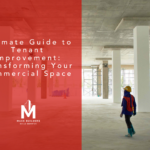Tenant improvement allowance (TIA) is a vital component of commercial leasing agreements. It offers tenants financial support to customize their leased spaces to fit specific business needs. This guide explores what tenant improvement allowances are, their benefits for both tenants and landlords, and how to effectively negotiate and manage these funds.
What Is Tenant Improvement Allowance?
Tenant Improvement Allowance refers to funds provided by landlords to tenants to finance renovations and improvements based on the square footage of the leased space. These funds are typically used for interior customizations of commercial spaces, including flooring, walls, and fixtures.
Benefits for Tenants
Tailored Workspace Design: TIAs empower tenants to transform a generic space into one that mirrors their brand and meets operational needs. This transformation can boost employee productivity and enhance customer perception.
Financial Flexibility: This allowance helps tenants preserve capital for other business areas as the landlord covers a significant portion of the initial setup costs.
Improved Lease Terms: Negotiating a TIA often leads to more favorable lease terms, such as reduced rent, as landlords value tenants who enhance the property’s long-term value.
Advantages for Landlords
Increased Property Value: Investments in tenant-specific improvements can significantly raise the property’s market value and appeal.
Competitive Edge: Offering generous TIAs can set a property apart in a competitive market, attracting more tenants and decreasing vacancy periods.
Stable Rental Income: Tenants are more likely to sign longer leases if they have invested in the space, providing landlords with steady income.
Effective Negotiation of Tenant Improvement Allowances
Market Research: Begin by understanding the typical allowance in your area to set realistic expectations for negotiations.
Strategic Planning: Submit a detailed plan and budget for the improvements to justify your requested allowance to the landlord.
Exploring Alternative Benefits: If a higher allowance isn’t possible, negotiate other perks like a rent-free period to balance the costs.
Optimizing Tenant Improvement Allowances
Prioritize Key Improvements: Focus your budget on changes that add the most value, such as energy-efficient systems and high-quality fixtures.
Budget Management: Secure multiple bids and possibly hire a project manager to ensure your project remains within budget.
Maintain Communication: Keep a clear line of communication with your landlord and contractors to ensure all improvements meet agreed standards and deadlines.
Navigating Challenges in Tenant Improvement Projects
Budget Overruns: To avoid exceeding your budget, ensure that your contracts with suppliers and contractors are detailed, specifying costs and responsibilities clearly.
Managing Delays: Set realistic timelines with buffer periods and perform regular progress checks to stay on track.
Key Elements of Tenant Improvement Allowance
Amount of Allowance: The allowance amount can vary based on property condition, lease length, and market conditions.
Scope of Work: Know which improvements are covered under the allowance for effective planning and budgeting.
Disbursement of Funds: Understand how funds are disbursed as it affects both the project’s timeline and financial management.
Strategies for Tenant Improvement Negotiation
Market Insight: Stay informed about current market conditions to strengthen your negotiation position.
Detailed Requirements: Outline your improvement scope and costs clearly to support your negotiation.
Professional Assistance: Consider engaging a broker or legal expert specializing in commercial real estate for negotiations.
Planning and Managing Improvement Projects
Budgeting: Ensure the allowance fully covers your project costs, including unforeseen expenses.
Scheduling: Align your improvement timeline with your lease commencement to avoid operational disruptions.
Legal and Regulatory Compliance: Check that all improvements comply with local codes and secure necessary permits.
Frequently Asked Questions About Tenant Improvement Allowance
What is a typical tenant improvement allowance? Allowances can vary widely, generally ranging from $10 to $50 per square foot, depending on location and property condition.
Can it cover any renovation? Typically, TIAs are for permanent fixtures and construction costs within the leased space. They usually do not cover movable items unless specifically agreed upon.
Who manages the improvement process? This can be managed by either the tenant or the landlord, depending on the lease terms. Some landlords may require approval over the contractors used.
What happens to improvements at the lease’s end? Permanent improvements usually become the landlord’s property. Tenants should understand lease terms regarding what can be removed or needs to be restored.
Is additional allowance possible during the lease? While uncommon, it’s possible to negotiate additional allowances during lease renewals or amendments if business needs change significantly.
How do allowances affect rent? Higher allowances might result in higher rent, as they are an investment by the landlord. Alternatively, tenants might negotiate lower upfront allowances for reduced rent.




